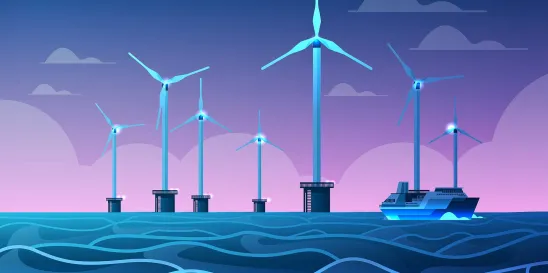Over the past year, a number of new interpretations related to the application of the coastwise laws to the developing offshore wind industry in the United States have clarified how construction and operation of offshore wind farms will proceed. The U.S. coastwise laws, which impose restrictions on the transportation of merchandise and passengers, as well as towing and dredging operations, are interpreted and enforced by U.S. Customs and Border Protection (“CBP”).
There was much uncertainty in the offshore wind industry for many years with respect to how the coastwise laws should apply to offshore wind farm construction and operation. Following the 2021 National Defense Authorization Act, which clarified that the coastwise laws apply to offshore wind on the U.S. outer continental shelf (“OCS”) as they do for oil and gas, CBP began issuing rulings applying the laws to the offshore wind industry—and industry is requesting more and more CBP rulings to clarify how the contemplated offshore wind work can be performed in compliance with the law. Although some issues are still pending, this article provides an update on some of the most recent and noteworthy interpretations.
Status of Project Crew
A number of personnel are required to install offshore wind turbines and perform related work while the turbine is being transported offshore by an installation vessel. These personnel are heavily involved in the installation work but are not involved in the navigation or operation of the installation vessel. The status of these personnel was unclear with respect to whether they would be considered crew or passengers, which would implicate passenger transport restrictions under the Passenger Vessel Services Act (“PVSA”).
CBP addressed the transportation of “project crew” for an offshore wind project in numerous rulings and determined that “project crew” include personnel who travel onboard a foreign flag vessel to project sites, including those personnel temporarily disembarking from a foreign flag vessel at each site to perform work on an offshore turbine foundation. CBP ruled that project crew would not be considered passengers under the PVSA if they are also performing tasks onboard the vessel that are “directly and substantially related to the operation, navigation, or business of the vessel,” which included work performed at each site. CBP also ruled that contract management personnel onboard a vessel to observe and monitor vessel operations did not constitute “passengers” because they serve a necessary business function of the vessel in performing offshore construction work.
Cablelaying
It has been CBP’s long-standing interpretation that cablelaying is not engagement in the coastwise trade and can be conducted by a foreign flag vessel because it is paid out, not unladen. In addition, CBP has confirmed that picking up cable laid prior and wet-stored on the seabed to connect it to another section is still part of the cablelaying operation. Once laid, however, the cable becomes a coastwise point. As such, the transportation of any subsequent installations, such as of mats, rock bags, or loose rock, to cover or protect the cable, would be subject to the coastwise laws if transported from a U.S. port.
CBP also recently confirmed its position with respect to return of surplus cable following a cablelaying operation. Although CBP initially stated that there was no “de minimis” exception, it later modified its initial ruling on surplus cable to acknowledge prior rulings that allowed up to five percent of the cable laden on the vessel to be unladen at a second coastwise point. Accordingly, any surplus cable that remains on the vessel after cablelaying may be landed at a U.S. port as long as it is five percent or less of the cable initially laden for the project.
Mechanical Dredging
Dredging in U.S. waters is restricted to coastwise qualified vessels. However, CBP has consistently ruled that use of certain devices to bury cable in the seabed for the purpose of cablelaying does not constitute dredging and may be conducted by foreign flag vessels. CBP has ruled that cable burial devices that use a jetting action to emulsify the seabed and temporarily displace the sediment, allowing the cable to sink down and bury into the seabed, is not dredging. Further, CBP recently ruled that use of a mechanical cutter burial tool to create a narrow slice of the seabed to bury a cable—one to 1.5-meter-deep trench approximately 0.25 to 0.45 m wide—was not dredging, even if the burial was done separate from the cablelaying operation. It would be prudent for operators to obtain CBP rulings approving the use of any new cable-burying technology.
Pristine Sites
CBP’s first ruling addressing pristine sites with respect to offshore wind farm construction was published in early 2021 in the context of scour protection. CBP originally ruled that pristine sites on the OCS, where there were no installations on the seabed, were considered coastwise points. However, CBP then modified the ruling to align with numerous longstanding rulings that found a pristine site was not a coastwise point. Therefore, a foreign flag vessel could transport from a U.S. port and install components at sites where there were no other installations.
CBP expanded on this ruling in July 2023 to address the installation of monopiles at pristine sites on the OCS. In that ruling, CBP found no violation would occur when an installation vessel loaded multiple monopiles at a U.S. port and proceeded offshore to install each monopile at pristine wind turbine installation sites on the OCS. CBP noted that once the monopiles were installed at each site, the first installation at each pristine site, the sites would become coastwise points and any future transportation to the sites must be done by a coastwise-qualified vessel.
However, this ruling was modified shortly thereafter, on September 14, 2023. In a long history of pristine site rulings for oil and gas and, more recently, offshore wind, CBP has never ruled that the pristine site analysis is impacted by whether the installation vessel touches the seafloor during installation at a pristine site. CBP modified its July 2023 ruling to differentiate between installation while a vessel is using dynamic positioning (“DP”) and while a vessel is anchored or jacked up. As noted above, the monopiles at issue in that ruling were to be transported from a U.S. port to a pristine site offshore, which would not be a coastwise point. After transporting the monopiles offshore, and before setting the monopiles on the seafloor, the installation vessel proposed anchoring or jacking up to install the monopiles.
The modified CBP ruling continues to state that transportation to and installation at a pristine site on the OCS is not restricted by the Jones Act because there is no transportation between two coastwise points. However, CBP revised its pristine site analysis to state that after transportation offshore to the pristine site, if the installation vessel anchors or jacks up to conduct the installation, the vessel itself becomes a temporary coastwise point and then when it unlades the monopiles during installation on the seabed, there would be a violation of the Jones Act because there has been transportation between two coastwise points. In other words, CBP has determined this constitutes a violation despite the fact that the transportation ended when the vessel arrives at the pristine site before it anchors or jacks up and there is no transportation of the monopiles after it anchors or jacks up and unlades the monopiles to perform the installation work.
CBP’s new interpretations of a pristine site and vessels unlading after the transportation is completed to the pristine site have potentially wide-ranging impacts on all offshore operations, both offshore wind and oil and gas.
Conclusion
As offshore wind continues to be a highly active and developing industry in the United States, CBP is publishing frequent interpretations on how construction of offshore wind projects must be accomplished. Unfortunately, some of CBP’s rulings have been unpredictable and have been subject to subsequent modification. This can have a drastic impact on the offshore industry, resulting in a volatile regulatory environment for industry stakeholders. It is critical that stakeholders keep a close watch on the publication of CBP rulings for any new and changing interpretations and review any planned operations for compliance.





 />i
/>i

